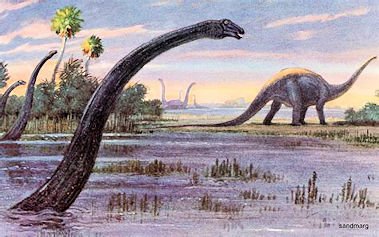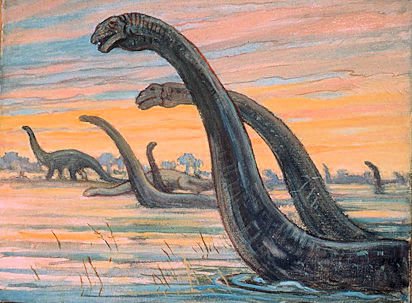Picking up where we left off in Part 3, and speaking of sauropod trackways (Falkingham 2012; Lockley et. al. 1986) which were made in relatively shallow water. Certainly, sauropods could spend time on solid ground and in shallow water, but where did they spend most of their time? Two remarkable paintings by Charles Knight suggested a water habitat (Knight 2005), but now many think they lived like elephants on open plains (Carpenter and Tidwell 2005).

Charles Knight

Charles Knight
Stress fractures of the pes might support the latter interpretation. Stress fractures exist in only half (half as in half examined or confined to certain subgroups?) the sauropods (Rothschild and Molnar 2005) and we see the same ratio in tail fusions (Rothschild and Berman 1991). Perhaps the stress of digging holes for the eggs predisposed the females to stress fractures in the feet. Perhaps position in mating or egg-laying can also account for the ratio in the tail vertebrae fusions. In either case, it is proposed the presence of osteological abnormalities of the feet and caudal vertebrae may permit us to determine the sex of dinosur skeletons and lead to a whole new set of inferences.
References:
Falkingham, P. L., Bates, K. T. and Mannion, P. D. 2012. Temporal and paleoenvironmental distribution of manus and pes-dominated sauropod trackways. Journal of Geological Society 169:365-370.
Carpenter, K. and Tidwell, V. 2005. Reassessment of the Early Cretaceous sauropod astrodon johnsoni Leidy 1865 (titanosauriformes). in Thunder Lizards: The Sauropodomorph Dinosaurs. Indiana University Press, Bloomington, pp. 78-114.
Rothschild, B. M. and Molnar, R. E. 2005. Sauropod stress fractures as clues in activity. in Thunde1991r-lizards: the Sauropodomorph Dinosaurs, Tidwell, V. and Carpenter, K. (eds.) Indiana University Press, Bloomington, pp 381-391.
Rothschild, B. M. and Berman, D. S. 1991. Fusion of caudal vertebrae in Late Jurassic sauropods. Journal of Vertebrate Paleontology 11:29-36.
Next, in Part 5: Can prediction of dinosaur behavior lead to advances in the field of medicine?
Yay @dinodoc! Another wonderful and informative post. I'm going to send it into the wild with a resteem so more people can learn about dinosaurs!
Thanks!
@originalworks
Some similarity seems to be present here:
This is an early BETA version. If you cited this source, then ignore this message! Reply if you feel this is an error.The @OriginalWorks bot has upvoted and checked this post! https://www.researchgate.net/publication/308797156_The_first_evidence_of_osteomyelitis_in_a_sauropod_dinosaur